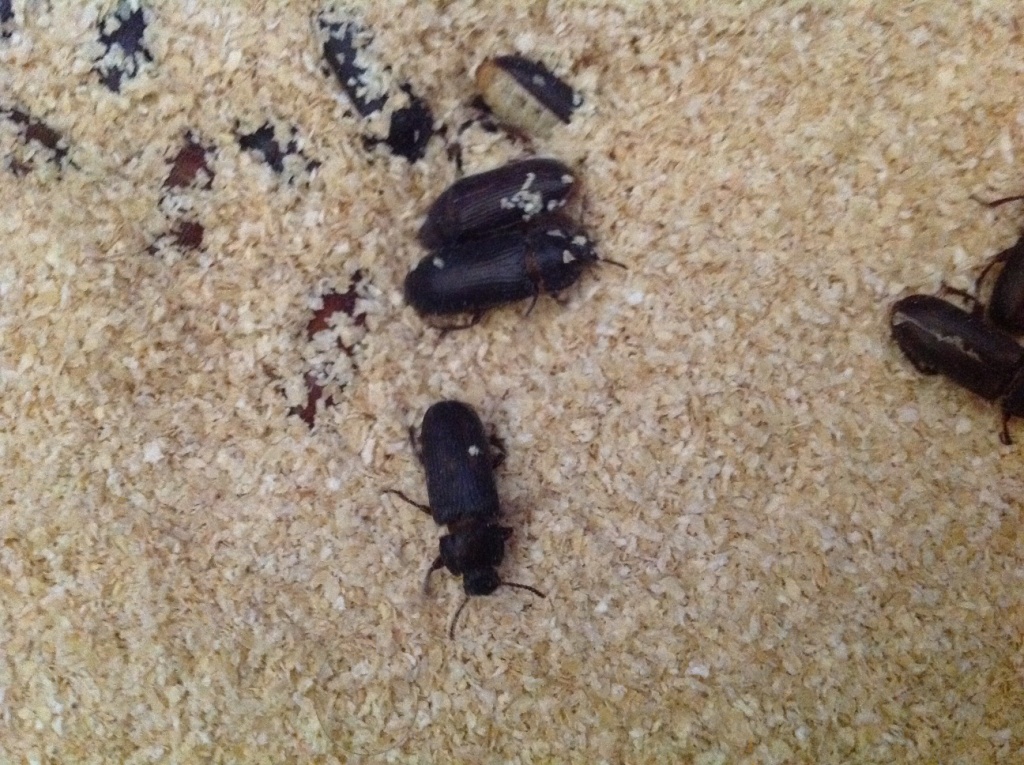An introduction to mealworms
Mealworms (telebrio molitor) are the larval stage of a species of darkling beetle. Mealworms are often grown in households to provide easy food for poultry (particularly backyard chickens), reptiles like lizards, a wide variety of fish as well as some mammals like sugar gliders and other natives. They are very popular as fishing bait because mealworms tend to last well on the line and are attractive to a range of fish.
Each worm will grow up to about 3cm in length before it becomes a pupa and finally changes into a black beetle. The four stages of the mealworm lifecycle are: egg, larva, pupa and beetle. The entire lifecycle will be complete within 6 months depending on the conditions that the worm is kept in.

What are the uses of mealworms?
Mealworms are a very versatile little critter. They are an excellent source of protein for pets and animals. We feed our mealworms to our backyard chickens and ducks. All of the birds love feeding on mealworms – particularly live ones.
An uncle of mine likes to grow mealworms for his lizards and bearded dragons. He has said that the lizards love feasting on live mealworms, and they provide much of the required nutrition for the animals. Unfortunately one night a mouse or rat got into his mealworms and ate them all. So let that be a lesson to protect your mealworms from potential predators!
Mealworms are also eaten by humans, and can be consumed baked or fried. Here is a recipe for Gourmet Mealworm Burgers on the BBC website. Personally I haven’t ventured that far (yet)!
As mentioned previously, mealworms are a popular type of fish bait. Apparently they are very good at staying on the line, which means that fishermen (and women) can continue fishing without needing to use more and more bait. As the worms are sought after by a range of fish, they are versatile and means that a range of fish can be targeted. They are also a very popular feed for fish in home made aquariums.
Due to their high protein and fat content, it’s important that mealworms are incorporated into a healthy diet for your pet. You can have too much of a good thing!

How to grow your own mealworms
It’s a relatively straightforward process to grow your own mealworms, but it’s important you follow some key steps to make life easier for you and the worms.
Feed
They will feed on a range of food, but we have used oats and wheat bran with good results. In fact we’ve upgraded to organic wheat bran to ensure that there are no chemicals that go into the mealworms and then get passed through to any pets. Due to the demand of our organic mealworms (by our own birds and also others looking for organic mealworms) we have a limited supply of stock available to the public. If you would like to buy some of our live organic mealworms, then please check out this page.
Mealworms will also require some moisture within their container. They need some water to feed off, but they will die from any mould that grows. This means that you will need to constantly monitor the container of mealworms so that they don’t all quickly die off. I have had a mould issue twice in the past, and with quick action to move all of the worms into another fresh container I did not suffer losses. There is a correlation between increased moisture and faster growth – the more moisture available to the mealworms, the faster they grow (and breed). The downside to increased moisture is the higher likelihood of mould which can kill your worms so it is important to find a balance.
Breeding
Mealworms will being mating a week after they have become a beetle. Males will find the females and mate with them, with the females expected to produce between 200 and 2000 eggs in her lifetime. Each of the eggs will be so small that you won’t be able to see it except under a microscope. There have been reports online that adult beetles will eat eggs if there is insufficient food or poor conditions in their container. I haven’t had this problem before. After 2 months mating, the beetles will die.

Learn more
As with all animals, you can always learn more. Growing your own mealworms can save you plenty of money and provide your animals with a nutritious snack, so getting your production right early is a smart idea. There are plenty of resources online about mealworm production, and we also sell a mealworms ebook detailing our own experiences – and how best to grow them.


Very informative
I just got mealworms today for breeding and are creating their home. My chickens are going to love them. We usually purchase the dried mealworms at our local ranch supply store, but, they have gotten so expensive. This is all new to me. Thank you for all your easy to understand information.